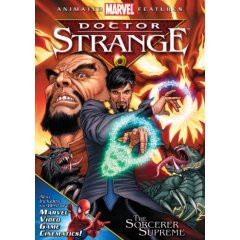Marvel’s animated features have had a mixed reception over the years, and 2007’s Doctor Strange: The Sorcerer Supreme landed squarely in that unpredictable territory. As a long-time Marvel fan, I approached this animated movie with hopeful anticipation, especially given the rich and visually stunning source material of Doctor Strange. However, after watching it, I found myself with a somewhat complicated reaction, leaning more towards disappointment than elation.
 Doctor Strange Animated Movie Poster: A retro-style poster showcasing Doctor Strange in his classic blue and yellow costume, promoting the 2007 animated film "Doctor Strange: The Sorcerer Supreme"
Doctor Strange Animated Movie Poster: A retro-style poster showcasing Doctor Strange in his classic blue and yellow costume, promoting the 2007 animated film "Doctor Strange: The Sorcerer Supreme"
Initial Impressions and Pacing Issues
The initial moments of the Doctor Strange Animated Movie felt sluggish. For a character known for his mystical and otherworldly adventures, the film takes a surprisingly long time to get going. The opening felt burdened by an attempt to make Stephen Strange instantly “likable,” a detour that ultimately detracts from the core of his character. Fans familiar with the comic book origin know Strange starts as a brilliant but arrogant surgeon. This initial arrogance and subsequent humbling are crucial to his transformation into the Sorcerer Supreme. The movie, in its attempt to soften his edges early on, unfortunately dilutes this important character arc.
Story and Character Deviations
The narrative broadly follows Doctor Strange’s origin story: a brilliant surgeon loses the use of his hands in an accident and seeks mystical healing, leading him to the Ancient One and the path of magic. However, certain alterations weaken the impact. In the comics, Strange’s car accident is often implied to be a consequence of his own recklessness and hubris – a direct result of his flawed character. The movie, however, attributes the accident to a mystical event, seemingly to absolve him of direct responsibility and make him appear more sympathetic from the outset. This change, while perhaps intended to streamline the story, diminishes the personal responsibility and karmic element inherent in Strange’s original downfall.
Furthermore, the film introduces Strange with a goatee, making him visually resemble Tony Stark/Iron Man from the preceding Marvel animated features. While a minor detail, it contributes to a sense of homogenization across these animated projects, rather than allowing each character to stand distinctly.
Animation Style and Tone
One of the most significant drawbacks of the Doctor Strange animated movie is its unremarkable animation style. Bland and generic are words that come to mind. Doctor Strange’s world is inherently psychedelic and visually arresting, filled with bizarre dimensions and magical energies. The animation, however, fails to capture this essential visual flair. It opts for a subdued, somber tone throughout, which clashes with the inherently fantastical nature of Doctor Strange’s universe.
The original review rightly questions, “remember when comics were fun?!” This sentiment resonates strongly when watching this animated feature. While mature storytelling has its place, superhero comics, and especially Doctor Strange, often thrive on a blend of wonder, adventure, and even a touch of the bizarre. This animated movie leans too heavily into a somber mood, sacrificing the inherent fun and visual spectacle that should be central to a Doctor Strange story.
Comparisons and Missed Opportunities
The review draws a compelling comparison to the Justice League Unlimited animated series, particularly its portrayal of Doctor Fate. DC’s animated universe, spearheaded by Bruce Timm, consistently demonstrated an ability to balance mature storytelling with the inherent excitement and wonder of superhero comics. Their rendition of Dr. Fate was indeed “spookier” and more compelling, capturing the mystical gravitas that feels absent in the Doctor Strange animated movie. The mention of a “Defenders story” in Justice League Unlimited using Dr. Fate as a stand-in for Strange further underscores the untapped potential for compelling mystical superhero narratives in animation.
The film also seems to miss an opportunity in its portrayal of Dormammu, a classic Doctor Strange villain. Described in the original review as lacking “kick,” Dormammu’s depiction fails to convey the cosmic dread and power he embodies in the comics. This is symptomatic of a broader issue with these early Marvel animated movies: a tendency to present watered-down versions of iconic villains, potentially in an attempt to make them more “relatable” or less overtly “comic book-y.”
Pacing Improves, But Issues Remain
Despite its initial sluggishness, the Doctor Strange animated movie does improve in its latter half. Once Strange embarks on his mystical training and Mordo’s betrayal unfolds, the narrative gains momentum. The action sequences and magical confrontations become more engaging, offering glimpses of the potential the film could have fully realized.
However, even in the improved second half, inconsistencies persist. The timeline, for instance, feels compressed. Strange’s training period in the temple seems brief, yet upon his return, characters involved in the initial storyline appear unchanged, despite the implication that significant time should have passed. This temporal compression weakens the sense of scale and transformation inherent in Strange’s journey.
Conclusion: A Mixed Verdict on Doctor Strange Animated Movie
Ultimately, Doctor Strange: The Sorcerer Supreme is a flawed but not entirely unenjoyable animated movie. While it suffers from pacing issues, a bland animation style, and deviations from the source material that dilute the character’s essence, it does possess moments of engaging storytelling, particularly in its latter half. For dedicated Doctor Strange fans, or those curious about animated superhero movies, it might be worth a watch, albeit with tempered expectations.
However, the film serves as a reminder of the untapped potential for Marvel animation. To truly capture the magic and wonder of characters like Doctor Strange, future projects need to embrace bolder animation styles, more faithful adaptations of source material, and a willingness to lean into the inherent fun and spectacle of superhero comics, alongside mature storytelling. Hopefully, future Doctor Strange animated movie endeavors will learn from the shortcomings of this initial outing and deliver a truly sorcerous cinematic experience.
